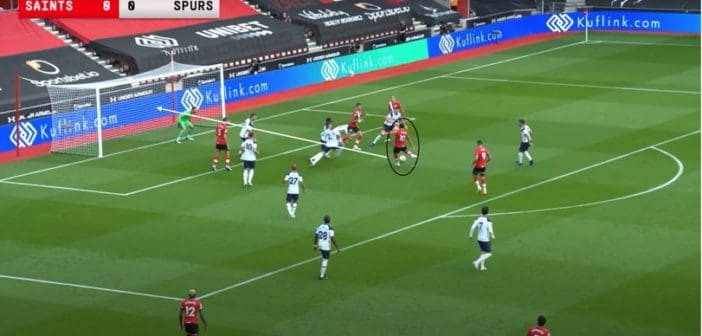If Che Adams was a golfer, you can be sure he’d use the driver everytime.
Most would concur there is a fine line between bad luck and bad finishing. Sometimes, those lines can become a little blurred. Perhaps it’s because of the fistful of intangibles that encompasses those fine lines, such as the kind of character you, yourself are, or how your own personal preferences directly correlate to how you view a game of football.
To illustrate this point, take an affable, laid-back individual. They may steer more on the side of optimism and put a missed opportunity down to bad luck. But their more abrasive, extroverted friend may surmise it as poor finishing, due to their need to conjure up tangible answers to their team’s shortcomings. As I said, it all depends on a lorry-load of indefinables which makes it difficult to quantify what the correct explanation would be.
Sounds confusing? Of course it does. But so is Che Adams’ shooting technique. And so is Southampton fans’ ability to conclude what side of the line their number 10 falls on.
When closely analysing Adams’ technique of his set-up to strike a ball, you are presented with an abundance of rather peculiar evidence, all of which points towards an idiosyncratic style of shooting. The slight nuances and finer details within his approach can make it difficult to pin down where his flaws lay.
So in the simplest terms, this writer has created a golfing analogy to (hopefully) explain Adams’ natural tendencies, both in his physical and mental mechanisms of shooting.
When a golfer has a set of clubs, they choose varying clubs for the varying situations they find themselves in. Essentially, it’s different horses for different courses. They wouldn’t select a driver on the putting green, for example.
But if Che Adams were to have a momentary dalliance with golf, he would choose the driver. Unquestionably. It would not matter if he was a yard away from the hole or 300, he’d always assume power prevails over precision. Clearly, if an actual golfer carried the same mindset in technique, it would be pretty reasonable to suggest their accuracy and consistency in shot would fast go downhill.
And that’s been the case with Che Adams this season.
If Danny Ings is seen as the super seducing, sumptuous finisher, that possesses the innate ability to lovingly caress the ball into the back of the net, Adams opts for the more meat-and-potatoes approach. Quite simply, Ings places it, Che Adams lashes it.
Like a golfer, power can occasionally lead to the extraordinary sublime. In football, take a 40-yard scorcher outside the box. But more often than not, they are a precious commodity. Exclusively using excessive power negates all the fundamentals of precision.
Before the West Brom game, Che Adams had taken the most shots of any player in the Southampton team. Yet, Ings was the only player who had his name pencilled on the scoresheets. Adams also had created the most passes leading to a shot.
Not only does this show Adams is picking-up threatening positions, but is also playing a defining role towards the end product of attacks.

Che Adams tops the chart for shots and passes leading to a shot – Photo: StatsBomb
But so far this season, despite the glut of chances, Che Adams has registered a solitary assist and no goals. In all fairness, it’s not been through the lack of trying.
When analysing Che Adams’ striking technique, there are some subtle mannerisms Adams relies on, no matter the goalscoring scenario. This can work on occasions, when the situation he finds himself in is conducive to his natural striking technique – goals against Bournemouth and Sheffield United last season underline this – but can also prove to be inconsistent and lead to near misses.
Take this instance below during the first half against Tottenham. At first look, it appears Che Adams is desperately unlucky and Hugo Lloris has pulled off a wonder save. My initial reaction was the same:
I swear Che Adams is the most unlucky striker in the league.
What a save from Hugo Lloris. Should be 1-0. #SaintsFC #SOUTOT
— Jacob Tanswell (@J_Tanswell) September 20, 2020
But when you breakdown the crux of the effort, there are some subtle flaws in Adams’ body mechanics that severely influence the shot being saved. He had a split-second to react and his natural inclinations came to the fore.
Ostensibly, Adams’ body shape offers a “tell” that it will be a side-footed shot, due to the direction of his in-step and the angle of which his back leg is coming from. His open hips also offer further clues. However, the genuine peculiarity in his technique is the amount of power that subsequently derives from the apparent side-footed shot. Because of the forward’s penchant for applying power rather than finesse, it means the side-footed strike ends up being a side-smash. The hurried manner in which Adams strikes it bares resemblance to a golfer who opts to use their sand wedge at the crucial moment.
Forget the elegant aesthetics, they rely on brute force to hammer the ball. In a golfer’s case it’s when they’re in the bunker. In Adams’s, it’s proven to be a first time finish in the box.
What’s particularly noteworthy is although Adams’ effort initially appears to have made good contact on the ball (which is where the regulatory shout of “unlucky Che” comes from), it’s unlikely he aims for the ball to go in that exact direction or at that exact height. In fact, he may well have been aiming to place the ball into the bottom left corner, hence the side-footed set-up moments prior to shooting.
But because of the fault in his body mechanics, upon the point contact, he naturally gets into a body position of where his back arches slightly further away from the ball than what would be expected. Leaning backwards results in the upwards trajectory of the strike and at a height which gives the Lloris a chance to produce a sheer reflex save. If Adams had struck a low shot, it would be difficult for any goalkeeper to get down and stop the strike, considering the closeness in proximity.
Minutes afterwards in the same game against Spurs, Adams misses another guilt-edged opportunity. But this one is a genuine peculiarity and seems to provide all sorts paradoxes in the striker’s technique.
As stated, Adams is a ‘have a go and hit’ it type of striker. But, somewhat unusually for a forward of his kind, Adams does feature a composure in and around the box, just before he shoots. In the still image below, Adams manufactures a shooting opportunity after a collection of small, sharp touches in a crowded box. Instead of shooting straight away, he bides his time and waits for the picture to change.
Adams’ rounds Ben Davies, who had attempted to make a sliding block. Adams delays pulling the trigger and ultimately finds a better angle to then fire. However, just at the pivotal moment, all poise pours out of him. Upon deciding the correct time to shoot, his step pattern become shorter and brisk, now becoming too eager to let fly. Despite all the calmness on display moments prior, he attempts to smash the ball in and bundle his way over the line. It hits the already grounded Davies.
While the sequence only lasts for a matter of seconds, it is telling that at the crucial moment, all serenity in his play dissipates.
Another example of Adams’ hit and hope style came against Burnley. Ryan Bertrand’s cut-back cross manages to find Adams, who had checked his run and successfully given himself a yard of space. But yet again, Adams’ natural instinct is to execute the effort with power, rather than precision.
In contrast to Danny Ings’ methodology of strike, Adams decides against using the pace of Bertrand’s cross to guide the ball in and instead opts to generate even more velocity on the shot.
Evidence suggests Adams’ modus operandi is erratic and unpredictable in its varying degrees of success. To put into its most succinct terms, it is an all or nothing type of technique. When it works, it rips the back of the net and gives the goalkeeper absolutely no chance, even if the strike is close to him. But when it doesn’t – which is more often that not – you witness the drawbacks of placing power over accuracy. It ends up sailing over way over the bar, as Adams does here. Again, note the natural arch in Adams’ posture is leaning away from the ball.
Perhaps Che Adams goalscoring troubles are accentuated when you have a striking artist alongside him, who just seems to paint the perfect pictures seemingly every time he’s in front of goal. If Ings’ finishing resembles the delicacies of a Vincent Van Gogh painting, Adams would be one of those contemporary, modern artists that splashes paint all over the canvas and hopes for the best. Sometimes it looks good, on other times you’re left wondering what on earth that was supposed to be.
Against West Brom, his link-up play was good and again showed the incremental developments he is making in his game. He no longer relies on goals as his currency of evaluating whether he had a good game or not.
His hustle and bustle style of pressing and his work-rate was faultless. But as with all strikers worth their salt, there needs to be a clear switch between the relentless intensity out of possession and the requisite poise in it. Right now, Adams cannot seem to differentiate the two. It’s all-action, 100 miles per hour for 90 minutes and that shows in his rushed finishing. All of which doesn’t exactly help matters cover the underlying flaws in his technique, either.
His substitution in the 83rd minute was met by a round of applause from the coaches and all of the bench, not to mention the hierarchy watching on from above. There are no signs of frustrations beginning to appear and so there shouldn’t. His work for the team has so far been receptive in Saints’ dramatic turnaround in form over recent months.
The team’s performance against West Brom was epitomised through Adams. Dominant yet unlucky, and on occasions, a few millimetres away from convincing entirely. It was hard-working and diligent, but could have had some further finishing touches applied to make it supreme.
Adams is now acclimatised to Hasenhuttl’s tactically-nuanced approach and the various automatisms that surrounds the side’s game without the ball. More pertinently, Adams has proven to be key to the attacking constructions of Saints’ play.
He is still contributing even when he’s not finding the net. But if he can find the net, then even better. Che Adams, take a breath – and shoot.
Follow us on Twitter @ProstInt
![Prost International [PINT]](https://prostinternational.com/wp-content/uploads/2021/08/PINTtFontLogoRoboto1536x78.jpg)



